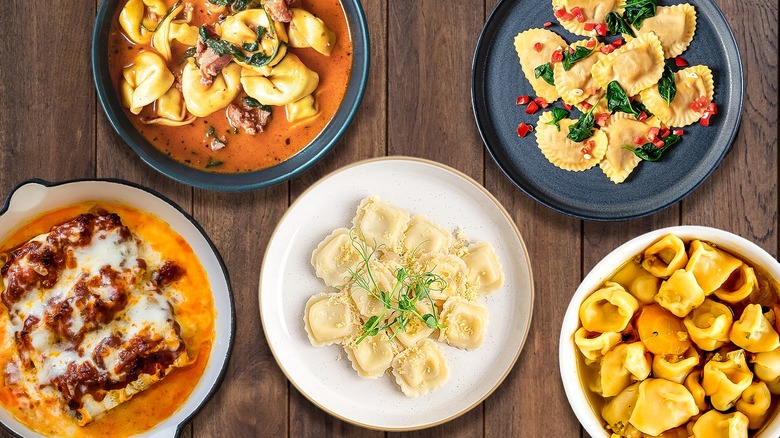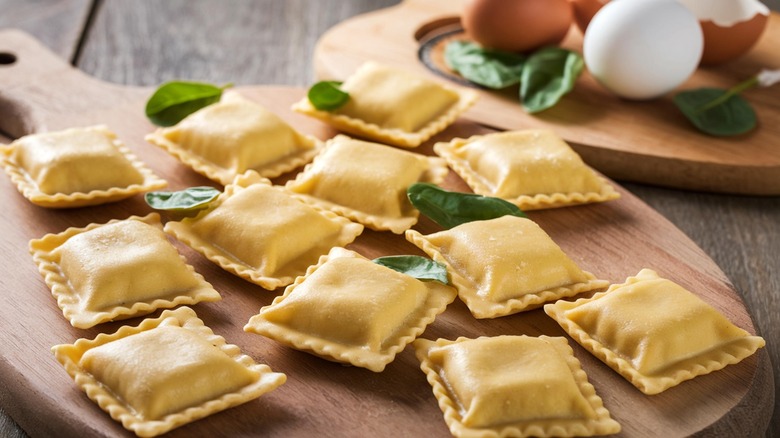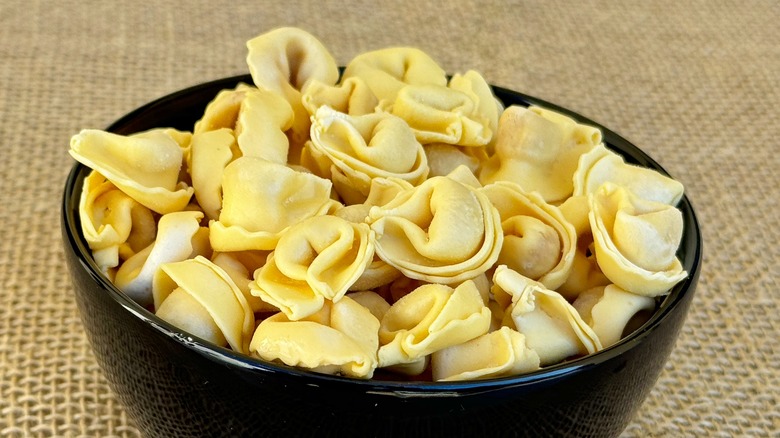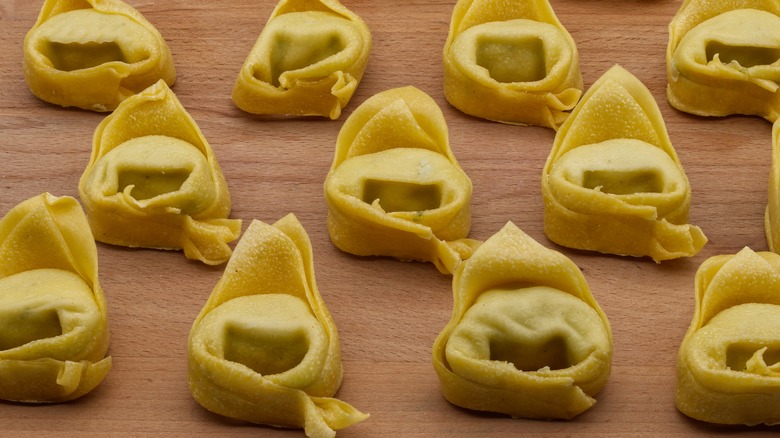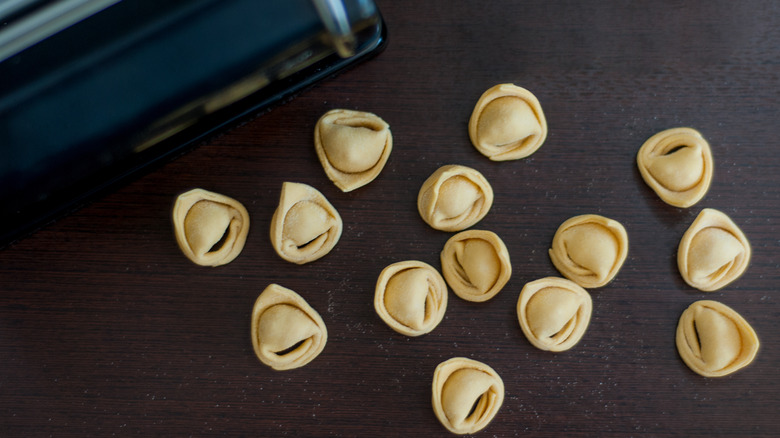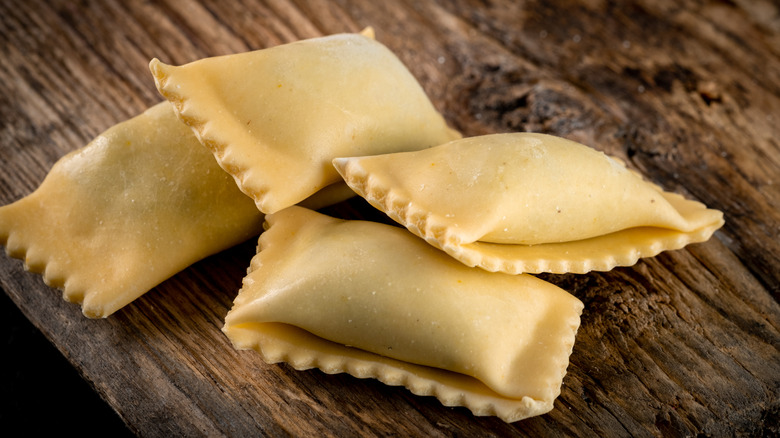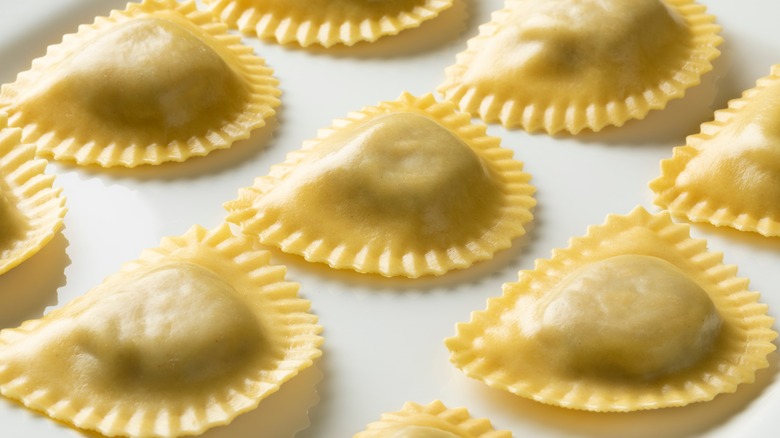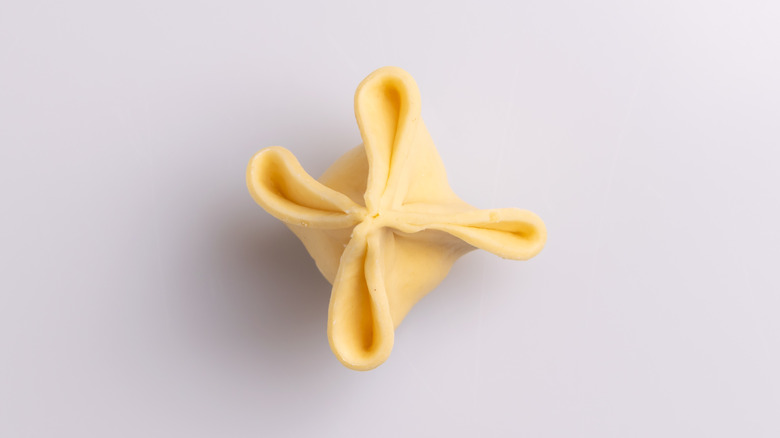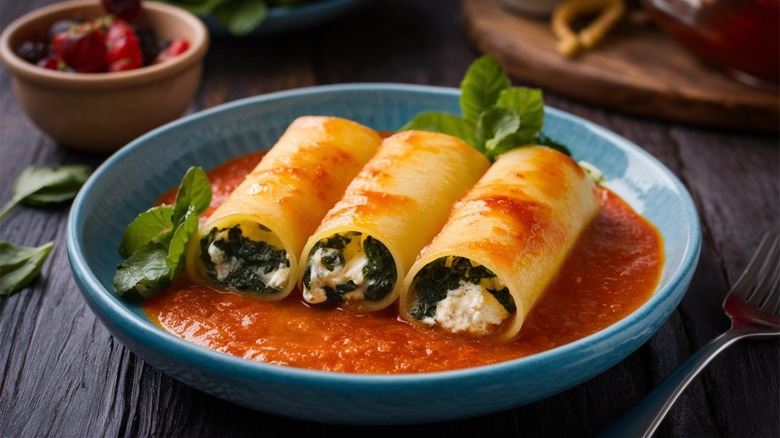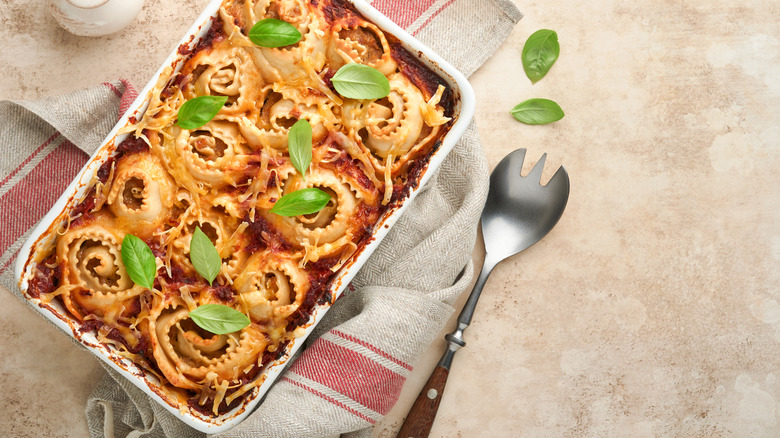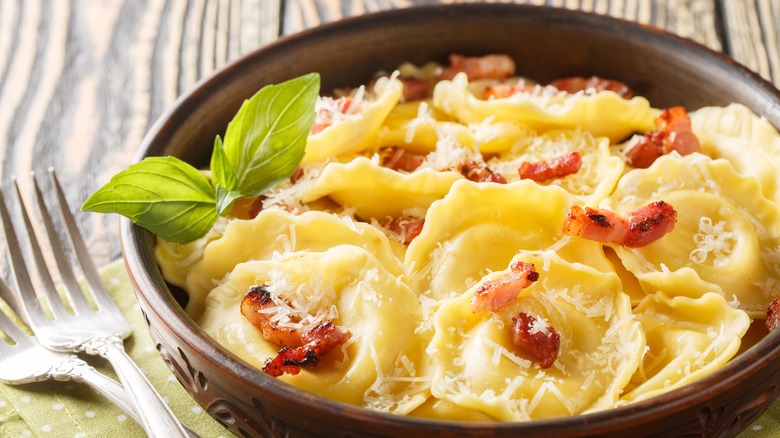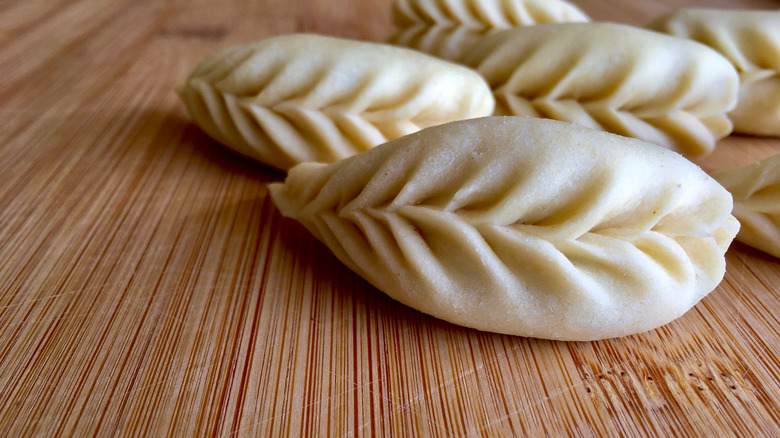11 Popular Types Of Stuffed Pastas, Explained
When it comes to pasta, spaghetti and macaroni have their place in the pantry of virtually every home cook, but stuffed pasta is a more luxurious option if you're in the mood to upgrade your midweek dinners. A comfort food that is both satisfying and packed with flavor, the wide variety of stuffed pasta means that you can choose an option that suits your family's tastes and the occasion.
For most of us, our stuffed pasta comfort zone involves ravioli and tortellini, but there are dozens of shapes and fillings out there just waiting to be explored. From meat-filled agnolotti to pumpkin-stuffed mezzelune, there's a world of lesser-known pasta dishes out there that can inject some fresh flavor into your meals.
While many Italians will tell you that each pasta type has a perfect sauce to match it, the great thing about introducing new stuffed pasta is that you can try it out with various sauces to see which one suits you best. From a classic marinara to a truffle-laced indulgent cream sauce, there's a sauce and pasta combination to suit everyone. So grab your apron, and let's explore 11 types of stuffed pasta that you can add to your must-try list.
Ravioli
When you think of stuffed pasta, ravioli are likely the first ones that spring to mind. Square little pillows of pasta with a choice of filling, they are instantly recognizable and can be paired with many different sauces.
The most common filling for ravioli is ricotta and spinach, a classic vegetarian combination that is both light and creamy at the same time. The word ravioli originally comes from the Italian verb riavvolgere, which means "to wrap," and you can pretty much wrap this pasta around any filling you like. Meat filling such as beef or veal is often used, but unusual ingredients such as lobster or chestnuts also star in regional variations.
A classic sauce that is often served with ravioli is burro e salvia, or butter and sage, which keeps things very simple and allows the pasta itself to shine. To make the sauce, simply heat butter in the pan until it starts to darken in color, add a few sage leaves, which will go crispy, and then add the drained ravioli and coat in the glistening sauce. This sauce will work with all flavors of ravioli without overpowering any delicate ingredients in the filling. A grating of fresh Parmesan cheese and a twist of black pepper will finish off the dish.
Tortellini
Tortellini are another type of stuffed pasta that you have probably heard of, though they are quite different from ravioli. They have a distinctive ring shape, made by folding the filled pasta around your finger, and they tend to be more meat-heavy than the often-vegetarian ravioli.
The most common filling for tortellini is a mixture of pork-based meats, such as mortadella and prosciutto, along with Parmesan cheese, though you may come across a spinach and ricotta version, too. This stuffed pasta tends to be popular in the north of Italy, particularly in the Emiglia Romagna region, of which Bologna is the capital. The shape of tortellini varies slightly between the Bologna and Modena regions, supposedly due to the finger they use to form them. In Bologna, the stuffed triangle of pasta is wrapped around the pinky finger, whereas in Modena, the index finger is responsible. Either way, the shape is said to resemble the belly button, though whose navel inspired it is debated!
A famous preparation of this pasta is in the soup tortellini in brodo, where they are served in a clear chicken broth. Making this dish from scratch is not a speedy job, so this dish is often made at family gatherings, including Christmas Eve, as the whole family can join in, crafting the tortellini and making the rich broth. If you are looking for a simpler way to prepare store-bought tortellini for a midweek meal, tortellini panna e fungi is a delicious option. Pair a cream and mushroom sauce with the meat-stuffed pasta.
Tortelloni
You may have seen tortelloni on the menu at your local Italian restaurant and thought it was a spelling error, but this is not the case. Though tortelloni may look similar in shape to their diminutive counterparts, the two pastas are quite different, and are not used interchangeably by Italians.
As a rule, tortelloni tend to be more vegetable-based, often stuffed with spinach or pumpkin. The Roman Catholic tradition of not eating meat on Christmas Eve means that vegetarian tortelloni often feature in Italian homes on this date. Their meat filling makes them very versatile, and they pair well with many sauces, from a simple tomato-based marinara to a more luxurious, creamy option.
If you are looking to venture into making homemade stuffed pasta, tortelloni are a nice option, as they are not too fiddly to make and a bit more unique than ravioli. Spinach and ricotta tortelloni don't take long to make, as long as you make the dough far enough in advance to allow it to refrigerate for a couple of hours before rolling it out. Adding mascarpone and Parmesan cheeses, as well as ricotta, will give you a decadent filling that will enhance the silky, homemade pasta. Serve with a simple sauce to allow your pasta handiwork to shine.
Cappelletti
At a glance, you may think that cappelletti are simply tortelloni, but any Italian — especially one from the region of Emiglia-Romagna — will know otherwise. Named after the Italian for "little hats," the main difference in shape compared to tortellini is that they are closed so that the filling is pushed upward, into a hat shape.
Cappelletti are generally meat-focused, with a mix of meats in the filling, and often served in a rich meat broth, too. Beef and chicken are often featured in the filling, and like most pasta dishes in the north of Italy, Parmesan cheese is likely to make an appearance, too. Their hearty nature means that cappelletti are enjoyed during the colder months as a warming comfort food, particularly when served in a piping hot broth. As such, you will regularly see cappelletti on Italian tables during the holiday season, including for Christmas lunch.
Cappelletti are not the easiest of Italian stuffed pasta shapes to make from scratch, so you may be better off buying them from your local Italian specialty store instead. Make a simple sauce such as a flavored butter sauce and enjoy with a generous grating of Parmesan on top.
Agnolotti
Agnolotti are a unique type of stuffed pasta that differ in both appearance and flavor from the more popular shapes such as ravioli and tortellini. Hailing from the Piedmont region of Italy, close to the borders of France and Switzerland, they are rustic in nature and are usually filled with a hearty meat filling. The pasta was originally designed as a leftover dish, so there is no "correct" way to make the filling, but a meat ragu is often used, though vegetarian versions do exist.
Agnolotti are made from rectangles of stuffed pasta, which are then pinched together at the edge and curved slightly into a crescent shape. They are versatile and can be served with a simple sauce to make the overall dish light, or coupled with a rich meat ragu to create a hearty option that will keep you warm in winter.
If you want to make yourself a vegetarian version, try our chestnut-filled agnolotti that works brilliantly with the creamy sauce. The earthy flavor of the chestnuts will cut through the rich cream, creating a balanced dish that maintains the essence of the classic dish from the mountains, but without the meat.
Mezzelune
It's easy to see how the next stuffed pasta on the list got its name — the unmistakable half-moon shape is part of what makes mezzelune such an elegant alternative to the usual ravioli. The pasta is very thin and delicate, meaning it tastes just as refined as it looks.
Mezzelune are a popular option in the north of Italy, particularly in the lesser-known region of South Tyrol. This part of northern Italy has influences from nearby Germany and Austria, and the stuffed pasta is also known as schlutzkrapfen.
The fillings for mezzelune tend to be heartier than you would find in other stuffed pasta, often containing potatoes or mushrooms, which fits with the alpine environment they are enjoyed in. However, not all mezzelune are vegetarian, and meat versions containing chicken or beef, or seafood varieties with shrimp are also common. Butternut squash is a delicious filling that works especially well in fall and pairs wonderfully with a white wine and cream sauce to create a sumptuous dish for the weekend. Whatever filling and sauce combination you choose, mezzelune are a striking version of stuffed pasta that will impress your dinner companions no matter what the occasion.
Fagottini
The next stuffed pasta on the list are the adorable little parcels known as fagottini. Translating literally as "little bundles," they look like a cross between a pyramid and a purse, and you will be desperate to tuck into these little pouches to find out what they contain. The answer, in most cases, is a vegetarian filing that could include spinach, mushroom, or even pears, along with some sort of cheese. Meat will sometimes make its way into the filling, often in the form of ham or prosciutto.
Like many types of stuffed pasta, fagottini give you a clear signal that they are ready to be removed from the pan. As the pasta cooks, the parcels will rise to the surface of the pan, and you should remove them soon after. The longer the pasta cooks, the more chance there is that the thin layer surrounding the filling will burst, causing the contents to spill into the water. Even a tiny hole can cause the fagottini to become waterlogged, ruining that particular parcel.
The sauce that will best match your fagottini will depend on the filling inside. A sweet filling, such as butternut squash or pear, will work well with a cream sauce, whereas a more savory filling, such as mushroom or spinach, will benefit from a simple, light sauce made from butter or olive oil. If in doubt, you can rarely go wrong with a classic tomato sauce.
Cannelloni
If you love a good lasagne — I mean, who doesn't? — but if you want to try something a bit different, it may be worth giving cannelloni a shot. It is similar to lasagna in that it consists of pasta covered in sauce and then baked in the oven, but it has a lighter feel due to the ingredients used. In the States, the cannelloni tubes are also known as manicotti.
The literal translation of cannelloni is "large tubes" whereas manicotti means "big sleeves;" both refer to the long, hollow shape of the pasta. The large tubes are then stuffed, usually with ricotta and spinach, before being covered in a tomato sauce, topped with Parmesan cheese, and then baked until bubbly and delicious. The main advantage of cannelloni over the rest of the stuffed pasta on this list is the size of the tubes and all of the space you have for stuffing. It means that you don't need to finely chop or mince the stuffing ingredients, and you can make a more rustic dish where the filling can be chunky and hearty.
There are many regional variations of cannelloni, from ground meat to mushroom and spinach, and of course, many of them feature cheese in the stuffing, too. If you are making your own cannelloni, feel free to experiment with your favorite foods as fillings and adapt the dish to whatever mood you are in. Remember to serve it alongside some rustic ciabatta to mop up any leftover sauce.
Rotolo
If you want to make a stuffed pasta dish that will impress even the most seasoned Italophiles, rotolo is the one to make. This little-known dish is what Jamie Oliver attributes the start of his celebrity career to, and with a little bit of effort, it can become the dish you are known for, too. Straightforward to prepare — if time-consuming — it is a visually stunning plate that tastes as good as it looks.
The literal translation of rotolo is "roll," which nicely describes the main preparation step for this stuffed pasta. Large pasta sheets are spread with filling, then rolled tightly into tubes before being sliced horizontally to create little rings stuffed with delicious filling. The filling can be virtually anything you want, though, like most stuffed pasta, ricotta, spinach, and ground meat are popular options.
The discs are then placed in a casserole dish before being surrounded by a tomato sauce and are baked in the oven in the same way as a cannelloni or lasagna. The dish is reminiscent of both of these classic baked pasta dishes, but its unique presentation makes it something special. The chances are none of your guests will have tasted rotolo, but they will certainly want it again after you wow them with this crowd-pleasing dish.
Girasole
Add a touch of sunshine to your plate with the beautiful stuffed pasta known as girasole. From the Italian word for "sunflower," these little circular parcels are scalloped around the edges, creating a pretty dish whatever the weather. They are not as popular as ravioli or tortellini, but they are often available to buy in grocery stores with a variety of fillings.
If you are looking for the perfect pasta dish in fall, girasole stuffed with pumpkin or butternut squash and sage are an excellent option. These sweet but earthy flavors pair well with a creamy mushroom sauce to create a pasta dish that is indulgent but not too heavy. The thin pasta used to envelop the filling means that girasole can provide a lighter option in comparison to some stodgier pasta dishes.
Take care when cooking, however, as the delicate pouches can rip easily, causing the precious filling to spill out and water to pour in, ruining your beautiful sunflowers. To avoid this culinary disaster, cook them at a simmer rather than a vigorous boil, and remove them as soon as they have cooked, which won't take more than a few minutes.
Culurgiones
Most varieties of stuffed pasta originated in the northern regions of Italy and are still most popular there today. At the opposite end of the country, however, you can find culurgiones, a unique Sardinian treat that look stunning on the plate. They are far removed from the appearance and flavor of the northern ravioli and mezzelune, bearing more resemblance to dumplings than their better-known counterparts. Another intriguing element of culurgiones is that the dough is egg-free, meaning that you can make a vegan version if you so wish. Traditionally though, they would include cheese in the filling.
When culurgiones are expertly made, the parcels are folded into long ovals, with the top being braided to look like an ear of wheat. This distinctive aspect of culurgiones sets them apart from the rest of the stuffed pasta and is designed to create good fortune for the August harvest. The most common filling is made from potatoes, Pecorino sheep's milk cheese, and mint. A simple sauce made from either butter or tomatoes will keep the flavors clean and allow the exquisite parcels to stand out on the plate.
